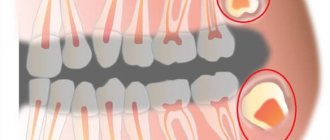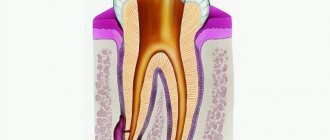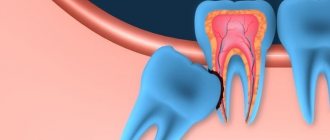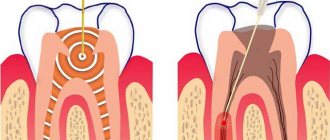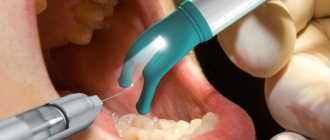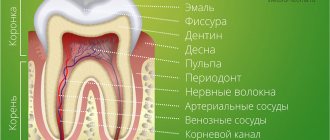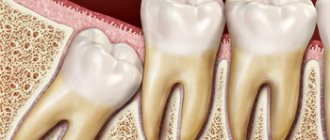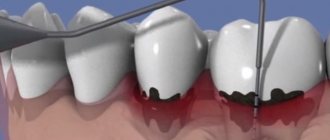Publication date: 01/25/2021
Every person's teeth are designed to last for many years. They have several levels of protection:
- Enamel is a highly durable mineralized tissue that protects the surface of the tooth.
- Dentin is a less hard tissue, but also strong. The main task of dentin is to protect the pulp - the inner tissue. It is the nerve endings in the pulp that signal us about the problem. If the surface layers are broken, we experience pain.
- Cement - covers the roots, protecting them from adverse influences
Overcoming these layers of defense is not easy, but it is possible. And then the teeth rot.
Causes of rotting
In the first place is fear. It is the irrational fear of the dentist, which is difficult to control, that makes us put off visiting the doctor. Often to the point where it is no longer possible to save the tooth. No matter what facts they give us, no matter how much we persuade ourselves, phobias do not lend themselves to rational arguments.
But this is far from the only reason.
General diseases
Our body is a single system. Discord in one place leads to problems in another. Thus, diseases of the gastrointestinal tract cause dental problems.
Infections, fungal diseases, even hormonal imbalances often lead to inflammatory processes in the mouth.
Ecological problems
In regions where drinking water is of poor quality, dental problems are 3-4 times more common. The same picture is observed where there are large industrial enterprises. Increased amounts of toxic microelements in the environment harm overall health and negatively affect teeth.
Diet
There are foods that provoke the growth of bacteria in the oral cavity, which means they contribute to tooth decay. Yes, that same sugar, but not only that. Acids formed during the fermentation of carbohydrates are the main enemies of enamel.
Lifestyle
Addictions of any kind are not good for dental health. Cigarettes, drugs, alcohol are a direct path to problems.
This also includes restrictive diets. Vegetarians, vegans, and Keto fans need to carefully ensure that the body receives all trace elements and vitamins.
Oral diseases
Inflammatory processes in the mouth are a haven for bacteria. Therefore, it is important to regularly carry out sanitation and ultrasonic cleaning of teeth. Periodontal disease, periodontitis, stomatitis, gingevitis, cheilitis require special treatment, which is better not to delay.
Oral hygiene
This is perhaps the easiest way to destroy teeth. All that’s left to do is brush and floss twice a day. 90% of the population does this, but not as carefully as we would like. There are special teeth cleaning schemes. They involve treating surfaces from all sides and for a certain time. Unfortunately, now
90% are those who brush their teeth for less than 1 minute.
Genetic predisposition
Alas, often all preventive measures are not able to help keep teeth safe and sound. Healthy, strong teeth, just like bad ones, are inherited.
Online consultation with a doctor
If you are concerned about the condition of your teeth and the symptoms described in this article: putrid odor, pain when biting, sensitivity of the enamel to cold, hot, sour, sweet, dark holes on the tooth, then it is best to undergo an examination and consultation with a dentist. Because these may be symptoms of deep caries, cysts, and other diseases. Bacteria or infection, entering the blood or lymph, affect healthy tissues, causing complications and illnesses. Which, if neglected, will lead to more expensive treatment:
- depulpation;
- dental restoration;
- deletion;
- dental implantation;
- prosthetics;
- treatment of adentia.
Dental implantation: positive and negative points
Many patients do not think at all about the dangers of hastily removing a tooth without any attempt to save it. For example, problems associated with a missing tooth include:
- an increase in the level of load on nearby teeth, which contributes to the deterioration of their appearance and stability. This problem can subsequently lead to the gradual destruction of neighboring healthy teeth;
- problems with speech as a result of the removal of several teeth at once;
- inability to lead a full life due to refusal of a number of food products;
- impaired smile aesthetics.
What is dental implantation? This is a procedure in which implants are implanted in place of lost teeth, over which crowns are subsequently placed. Thanks to this simple procedure, the patient receives teeth that look no different from natural teeth.
The advantages of dental implantation include:
- the presence of a special structure in dental implants, providing them with a long service life. Many implant manufacturing companies provide a lifetime warranty on their products;
- the ability to fully chew all kinds of food after the rehabilitation period and not be afraid to brush your teeth. In terms of functionality, implants are fully capable of replacing natural teeth;
- positive impact on the aesthetics of the smile, since implants cannot be distinguished from natural teeth;
- the ability to restore one or several teeth at once.
Stages of decay development
There is no acute form of caries, so small changes are difficult to notice, they accumulate - and now a person cannot smile, only stumps of teeth remain. Therefore, it is important to undergo preventive examinations regularly. The dentist can identify the problem at the initial stage and can easily fix it.
- Rotting begins at the spot stage. The color of part of the surface changes. Enamel demineralization begins. At this stage, treatment is quick and easy.
- The superficial process of demineralization is increasing, but the pain syndrome has not yet manifested itself. The tooth can react to sweet, sour, cold, hot.
- Middle stage The lesion reaches the enamel-dentin junction. Painful sensations occur periodically. Large areas are affected.
- Deep damage The decay process affects the dentin surrounding the pulp. If this process is left unattended, pulpitis will develop. And this is far from the only problem.
Symptoms of wisdom tooth caries
The main danger of the disease is that it is asymptomatic for a long time. And if the patient ignores regular preventive examinations at the dentist, he will learn about the problem at a deeper stage. For example, cervical caries of a wisdom tooth is often discovered only when the patient begins to suffer from sudden pain.
At first, a dark spot appears on the enamel, but it is difficult to see, because the tooth is located far away and at an angle. There is no pain because the enamel is devoid of nerve endings.
As the disease progresses, it continues to destroy the enamel and reaches the dentin. Here the first symptoms begin to appear - bad breath, and sometimes short-term pain under the influence of mechanical, temperature and chemical stimuli. You need to remember: if your wisdom tooth hurts, caries is most likely the cause.
Dentin is a porous tissue, so at the middle stage the disease begins to progress very quickly: demineralization of the tooth occurs and necrotic changes begin. Deep caries of a wisdom tooth is characterized by damage to hard tissues, which is why the tooth reacts strongly to hot and cold, sour and sweet. A prolonged aching pain occurs, the coronal part is severely destroyed.
Complications
Bad teeth are a direct path to a heart attack
. When the tooth's protection is destroyed, bacteria enter directly into the bloodstream. There they can provoke the development of blood clots, inflammation of blood vessels, and this leads to the development of coronary artery disease, which is not far from a heart attack.
Gastrointestinal problems
Rotten teeth make it difficult to chew food well. Not only do poorly chewed pieces irritate the mucous membrane, pathogenic flora from damaged teeth enters the stomach and intestines, where they can multiply uncontrollably, causing diseases such as gastritis, pancreatitis, stomach ulcers and duodenal ulcers. Competent gastroenterologists always advise visiting a dentist.
Diseases of the throat and nose
A constant source of infection in the mouth means that any malfunction in the body will cause a relapse of diseases such as sore throat and sinusitis. Purulent infections are dangerous because they can lead to blood poisoning. And such diseases are difficult, often causing complications. Inflammation of the tonsils often causes rheumatism and heart problems. Those who struggle with chronic sinusitis need to especially carefully monitor the condition of the oral cavity. Chronic manifestations will not go away if there are rotten teeth in the mouth.
And the head too
An advanced inflammatory process can spread to the trigeminal nerve. It is closely connected with the brain, and this is a serious matter. Chronic migraines, memory problems, even Alzheimer's disease are associated with oral health. Although there is no direct evidence that Alzheimer's is caused by the same bacteria that cause inflammation in the mouth, it is better to be on the safe side.
Abscesses and cellulitis are also the result of bacterial inflammation.
What to do when the process of tooth decay begins
Modern dentistry is not about pain at all. This is about caring for the patient and the desire to preserve his teeth.
Dentists' advice is simple, but how many people follow it?
How to prevent teeth from rotting:
- Lead a healthy lifestyle
- Takes good care of your teeth
- Carry out hygiene procedures regularly
- Monitor your general health
Plaque on teeth is the beginning of the decay process. Regular cleaning of tartar is one way to keep your teeth healthy.
The process of removing a wisdom tooth in the gum
The removal operation consists of the following steps:
- Preparation. To reduce the risk of postoperative deposits, sanitation of the oral cavity and professional hygiene are carried out with the removal of dental deposits. Elimination of pathological microorganisms and foci of infection promotes rapid wound healing without complications.
- Anesthesia. Before the operation, local anesthesia is performed using a carpule syringe and modern painkillers. The anesthetic is selected for each individual, taking into account individual sensitivity, age, and medical history.
- Creating access to the tooth. In case of retention, the dentist must provide good access so that the forceps can be securely fixed. To do this, size the gums and, if necessary, remove the bone and gingival hood.
- Extraction. The difficulty of molar removal depends on the type of retention and the individual situation. The tooth is fixed with forceps and dislocated; if necessary, additional instruments are used.
- Procedures after removal. After extraction, the tooth socket is inspected and bone fragments and protrusions are removed. The doctor applies a gauze pad and, if necessary, medications to stop bleeding. Sutures are placed on the gum to speed up healing.
- After surgery, the patient is given instructions, advice, and recommendations in the postoperative period.
Treatment
Sick teeth need to be treated, the sooner the better. The dentist’s task is to save the tooth, but if measures are not taken in time, it will have to be removed to avoid serious consequences.
Methods:
- Remineralization Applications of calcium and fluoride preparations and electrophoresis help restore enamel at the initial stage.
- Filling the cavity The affected tissues are removed, their place is filled with filling material.
- Partial prosthetics A crown is placed on the tooth, which protects it from mechanical and biological influences. The crown is placed on a previously depulped, dead tooth.
- Removal If the pulp is affected and the inflammatory process threatens to develop into an abscess, the tooth is pulled out. You should not resist the removal of rotten teeth - they do nothing but harm.
It is easier to prevent any process than to take a long time to eliminate the consequences. By following simple preventive measures and regularly visiting the doctor, you can avoid tooth decay and maintain your smile and self-confidence for many years.
Treatment of wisdom tooth caries
Despite the irrationality of preserving the eight tooth, sometimes the doctor recommends abandoning extreme measures and prescribes treatment for the eighth tooth.
Indications for removal of a wisdom tooth with caries
- Caries is at an early stage: the tooth can be saved, and treatment will not be difficult or expensive.
- The figure eight is involved in prosthetics - for example, it is a support for a bridge or clasp prosthesis.
- The tooth erupts normally, without deviations.
- There is an antagonist that will ensure uniform distribution of the chewing load.
- Removing a wisdom tooth with caries is contraindicated due to pregnancy or other reasons, but it is necessary to stop the spread of infection.
Therapy proceeds as follows:
- the affected tissue is removed with a drill;
- the resulting cavity is disinfected with antiseptic agents, an insulating gasket is placed on the bottom;
- the cavity is filled layer by layer with a composite material, which hardens under the influence of a photopolymer lamp;
- The shape of the tooth is adjusted using a drill so that it looks natural and ensures complete closure with the antagonist tooth.
So if you are wondering whether wisdom teeth cure tooth decay, then the answer is yes. However, it is important to consult a specialist in time and not to advance the disease.
